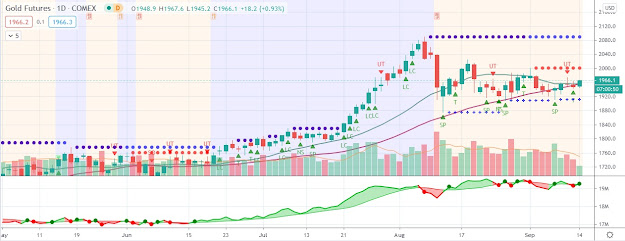Gold Price Bubble?

The commonest answer to why gold has been rising has been that the dollar has been weakening, making the metal, which is sold in dollars, cheaper in other currencies and acting as a hedge for dollar investors. But the strong inverse correlation between the two is fairly recent. As little as six months ago it was not there. Even closer than that — in early October and early November — there were periods when the two failed to march in lockstep at all.
So there must be something else at work at well, given that spot gold hit another record high, above US$1,226 (RM4,168) an ounce, yesterday. That was not really a record high, of course. On an inflation-adjusted basis, it would need to get up to more than US$2,150 to match where it was at the London fixing on January 21, 1980. But the rise has still been remarkable, racking up a near 60 per cent gain in the past year. Michael Dicks, head of research and investment strategy at Barclays Wealth, reckons a lot of the demand for gold is down to confidence, to investors wanting something they can grasp onto in an era of uncertainty about the global
 “People feel more confident in tangible investments,” But why now? Gold was discarded along with just about everything else except cash in 2008 when the world was fearful of a financial meltdown. It lost 33 per cent in the quarter that Lehman Brothers went bust. And although there are signs of investors becoming more cautious — such as in the Reuters asset allocation polls for November — there is no sign of a sharp retreat from this year’s risk rally.
“People feel more confident in tangible investments,” But why now? Gold was discarded along with just about everything else except cash in 2008 when the world was fearful of a financial meltdown. It lost 33 per cent in the quarter that Lehman Brothers went bust. And although there are signs of investors becoming more cautious — such as in the Reuters asset allocation polls for November — there is no sign of a sharp retreat from this year’s risk rally. Indeed, world stocks as measured by MSCI hit a 14-month high yesterday, just as gold was hitting its new peak. In the past, gold has been widely used to combat inflation, so its current rise could be an argument for the devaluation of currencies as a result of authorities essentially printing money to pump liquidity into the system. “There is generally a lack of confidence in money in developed markets,” said Max King, strategist at Investec Asset Management.
There is little sign of any immediate inflation, however. The Organization for Economic Co-operation and Development projects US inflation at 1.7 per cent next year then 1.3 per cent in 2011. It sees prices in the euro zone up 0.9 per cent then 0.7 per cent. There may be longer-term fears of inflation at work, but this has not been recorded as  strongly in other hedging instruments. Demand for US Treasury inflation-protected securities, or TIPS, has risen but it is more of a normalisation from a near complete rout during the height of the crisis. Breakeven spreads on 10-year Treasuries suggest expectations of just over 2 per cent US inflation over that horizon.
strongly in other hedging instruments. Demand for US Treasury inflation-protected securities, or TIPS, has risen but it is more of a normalisation from a near complete rout during the height of the crisis. Breakeven spreads on 10-year Treasuries suggest expectations of just over 2 per cent US inflation over that horizon.
Many point out that if you are looking for an inflation problem, it probably is not lurking in the big western economies but further afield in the fast-growing emerging world. Baseline forecasts by the International Monetary Fund have developed country inflation at large this year at a virtually non-existent 0.1 per cent — yet it sees 5.5 per cent inflation in the developing world.
But even this picture is hardly scary, looking ahead. While the IMF’s average estimate for major country inflation for the four-year period to 2014 should pick up slightly to 1.7 per cent, it sees emerging country inflation slowing to 4.2 per cent. These are not the figures of inflation nightmares and hoarding bullion. King’s Investec, meanwhile, puts the most recent rally down to the reversal of a decades-long selling of gold by developed economy central banks to net buying by emerging market authorities.
That is based at least in part of a desire to diversify away from the dollar and it is enough, according to Investec, to put a new floor on gold of around US$1,000 an ounce. But for central banks to continue buying at a rate that can drive the market from current levels, would not the dollar need to show some real signs of being ditched as a reserve currency? For all the concern about that, a precipitous move away from the dollar as a biggest world currency is still a low-probability event for many economists and policymakers around the globe.
All the reasons for gold’s rise are perfectly satisfactory but the fact that there are so many could suggest that at current prices all that is happening is momentum — buy it because it has been going up and others are doing so.
Bubble, anyone?


Comments
Post a Comment